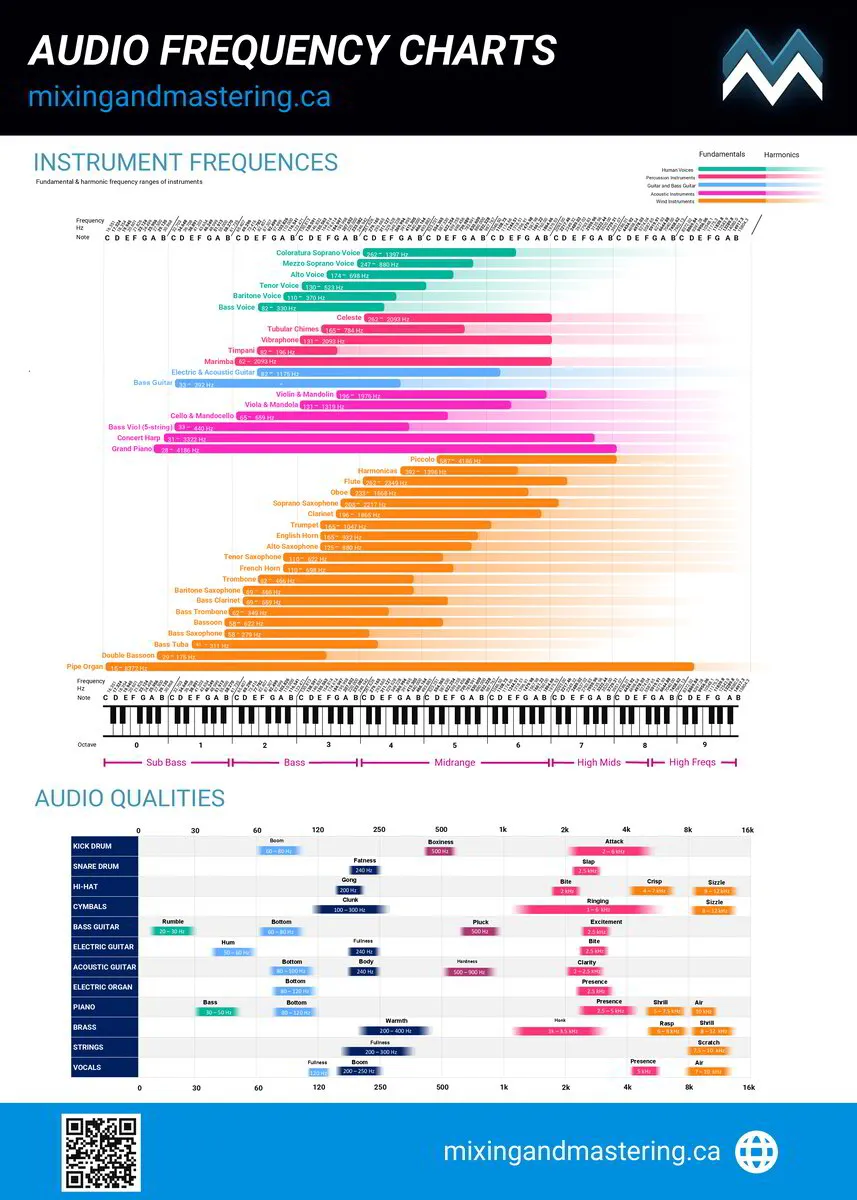What is EQ?
Equalization, commonly referred to as EQ, is an incredibly useful audio tool for musicians and sound engineers. EQ allows you to adjust the volume levels of specific frequencies within an audio signal. Using EQ enables you to shape the overall tonal balance and timbre of recordings, live sound, or electronic instruments.
With EQ, the volume of bass, midrange, and treble frequencies can be turned up or down as needed. Boosting certain frequencies can make instruments and vocals cut through a mix better or help compensate for acoustic deficiencies in a venue. Attenuating other frequencies can remove unwanted resonances or mask overly bright/boomy sources. Careful EQ moves can add clarity, warmth, punch, space, and life to your audio.
Graphic and parametric EQs give detailed control over narrow or wide bands. EQ plugins in DAWs provide quick sound sculpting on individual tracks. Hardware EQs color the sound in analog consoles and outboard gear. Understanding and mastering equalization techniques is critical for any musician or audio engineer striving to achieve professional results.
Frequency Spectrum
The frequency spectrum refers to the entire range of frequencies that make up a signal, from the lowest frequency to the highest. The audible frequency spectrum for humans spans from 20 Hz to 20,000 Hz.
20 Hz represents the lowest bass tones we can hear, while 20,000 Hz marks the upper limit of our hearing range. Most adults can't hear much above 16-17 kHz as we age. All the frequencies between these two numbers will consist of what we can hear, and all your musical instruments and your voice will be within this range.
When viewing a frequency spectrum visually, lower frequencies appear on the left and higher frequencies on the right. The amplitude or volume level at each frequency is displayed as vertical bars or a continuous line. Analyzing a frequency spectrum helps reveal which frequencies are most dominant in a particular sound.
EQ and audio filters work by boosting or cutting selected frequency ranges in the spectrum. Identifying problem resonances or lacking frequencies in a spectrum graph allows precise correction with EQ. Our ears can only discern so many frequencies at once, so controlling the frequency spectrum is key to creating clean, appealing mixes.
Instrument Frequency Chart Explained
Okay, now that we know what EQ is and the frequency spectrum we can dive into this chart. I will go through this chart section by section.
There are two graphs to go through, "Instrument Frequencies" & " Audio Qualities".
Fundamental Frequencies & Harmonics
On the right hand side there is a color coded legend. The thicker colors will be your fundamental frequency range for a sound, and the more faded part of the colors will be the harmonic frequencies.
When you play a musical note, it has a main pitch. This main pitch is called the fundamental frequency. It's like the backbone of the note.
But that musical note also contains higher pitches that are multiples of the fundamental. These extra pitches are called harmonics or overtones. They give the note its unique sound color or tone.
For example, when you pluck a guitar string, it vibrates at its fundamental frequency. But it also vibrates at higher frequencies - the harmonics. The fundamental frequency determines the main pitch you hear. The harmonics add color and brightness.
All together, the fundamental and harmonics make up the complete sound of the note. The fundamental is the main pitch, and the harmonics add texture and tone. This blend of frequencies gives each instrument its distinctive sound.
So in simple terms, the fundamental is the core pitch, while harmonics are extra pitches that provide overtones and color. Together they create the rich sounds we hear in music.
Frequency Hz
At the top of the chart you will have the frequencies. Each note has a specific frequency tied to it, determined by which octave you are in. On the left side of the chart is the lower frequencies or bass notes and the more right you go the higher the notes and frequencies.
Notes
Under the frequencies you will have your notes, sectioned off by octaves.
Instruments
This is a chart of where common instruments sit within the frequency range, measured with their fundamental and harmonic frequencies. You can check the color legend in the top right to differentiate fundamentals vs harmonics.
Below is all the fundamental ranges of each instrument.
Vocals
At the top we have in green the different vocal types. Here they are with their vocal ranges and notes.
- Coloratura Soprano - 262Hz - 1397Hz
- Mezzo Soprano - 247Hz - 880Hz
- Alto - 174Hz - 698Hz
- Tenor - 130Hz - 523Hz
- Baritone - 110Hz - 370Hz
- Bass - 82Hz - 330Hz
Vocals have some of the smallest ranges, although they will still have plenty of information in the low and top ends due to room noise, and how your vocals were recorded. A lot of the character and how the vocals sound come from the harmonics of the voice, so do not neglect these areas.
Percussion Instruments
Percussion instruments are in red. Here are their ranges.
- Celeste - 262Hz - 2093Hz
- Chimes - 165Hz - 784Hz
- Vibraphone - 131Hz - 2093Hz
- Timpani - 82Hz - 196Hz
- Marimba - 62Hz - 2093Hz
Guitar & Bass
Guitar and bass are in blue. Here are their ranges.
- Electric Guitars & Acoustic Guitar - 82Hz - 1175Hz
- Bass Guitar - 33Hz - 392Hz
Acoustic String Instruments
Here are the acoustic stringed instruments in pink, along with their ranges.
Violin & Mandolin - 196Hz - 1976Hz
Viloa & Mandola - 131Hz - 1319Hz
Cello & Mandocello - 65Hz - 659Hz
Bass Viol - 33Hz - 440Hz
Concert Harp - 31Hz - 3322Hz
Grand Piano - 28Hz - 4186Hz
Wind Instruments
Finally we have the wind instruments in orange. Here are their ranges.
Piccolo - 587Hz - 4186Hz
Harmonica - 392Hz - 1396Hz
Flute - 262Hz - 2349Hz
Oboe - 233Hz - 1568Hz
Soprano Sax - 208Hz - 2217Hz
Clarinet - 196Hz - 1865Hz
Trumpet - 165Hz - 1047Hz
English Horn - 165Hz - 932Hz
Alto Sax - 125Hz - 880Hz
Tenor Sax - 110Hz - 622Hz
French Horn - 110Hz - 698 Hz
Trombone - 82Hz - 466Hz
Baritone Sax - 69Hz - 466Hz
Bass Clarinet - 69Hz - 659Hz
Bass Trombone - 62Hz - 349Hz
Bassoon - 58Hz - 622Hz
Bass Sax - 58Hz - 279Hz
Bass Tuba - 41Hz - 311Hz
Double Bassoon - 29Hz - 175Hz
Pipe Organ - 16Hz - 8372Hz
Audio Qualities
Subjective audio qualities refer to descriptive words that are used to convey the perceptual aspects of how audio sounds. These terms are subjective because they describe qualities that are perceived differently by each listener. Here are some common ones:
Bite - The sharpness and attack of the sound, especially for percussive instruments. Describes the crispness and clarity.
Thump - The deep, visceral power and weight of low frequencies that you can feel in your chest.
Presence - The intimacy and detail of the sound, as if it's "in your face." Conveys clarity and nuance.
Air - The sense of openness, ambience and reverberation around the sound. Describes the expansiveness and soundstage.
Warmth - The richness and fullness, especially in the lower mids and bass. A warm sound is pleasing and vibrant.
Brightness - The emphasis on upper frequencies and treble, adding shimmer and sheen. Can also imply harshness if excessive.
Punch - The dynamic impact and strength of the sound's attack and transient. Similar to bite but conveys a strong attack.
Boominess - An overemphasis on resonant low frequencies, resulting in muddled or muddy sound.
Sibilance - Harshness and prominence of high frequency 's' and 't' sounds. Caused by too much boost around 6-8kHz.
These qualitative terms help communicate subtle aspects of the sound that cannot be fully described by technical specifications alone. Understanding these subjective qualities can help uoi in analyzing and dialing in a desired sound.
Here are some of the common qualities that instruments have. Use this for when you are EQing. These will be common area to look out for. Remember to always use your ears. Not every quality here needs to be changed at all times.
How to Use The Frequency Chart
You can use these charts to help you better determine areas to EQ or help with sound selection. Having sounds within the same frequency range can have instruments being hidden also known as "masking". When two sounds sharing the same exact frequency, they can cut each other out.
Going through where the instruments sit in relation to each other can help you determine where areas may be masking, and you can then eq accordingly.
The bottom chat is also great if you are looking for the specific word to get for an area that may need EQing.
As an example: Bass
It may be hard to distinguish the low frequency instruments that are causing problems in the mix. Say your bass sounds are clashing, specifically your piano and kick. One may sound boomy (60Hz-80Hz) and the other may have too much sub bass (30Hz-50Hz). If you don't have a frequency analyzer it can benefit you to see what may be clashing on the chart. Then you can add a high pass filter to the appropriate sound and move on!
You can also see what is lacking. Say you have a vocal track and it doesn't sound as forward in the mix as you want it. You can see it may be lacking some presence. Now you can go to the chart and see if boosting around 5000Hz fixes your problem.
Remember it is always best to trust your ears instead of using your eyes with these charts. Every song is different and you should be EQing accordingly. These are just starting points, and are subjective.
Conclusion
These EQ cheat sheets are a great way to learn the different ranges of sound. Using your ears to find problem frequency ranges can be hard, especially if you don't have seasoned ears. Using a cheat sheet like this one above can help you directly find the range you are hearing problems in, and find what the instrument you need to fix sits at.
While specific ranges can vary across different sources, these charts provide helpful starting points. Get to know the general frequency home of sounds like kick drums, guitars, and vocals. Experiment with gentle cuts and boosts in these areas, being careful not to overdo it. With practice, reading EQ cheat sheets will become second nature, allowing you to make fast tonal balancing moves. Don't view them as firm rules, but as guides to informing your own mixing decisions. Learn the fundamentals and then trust your ears.











